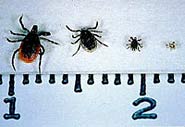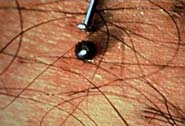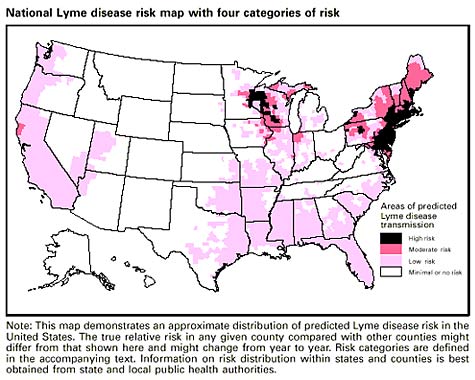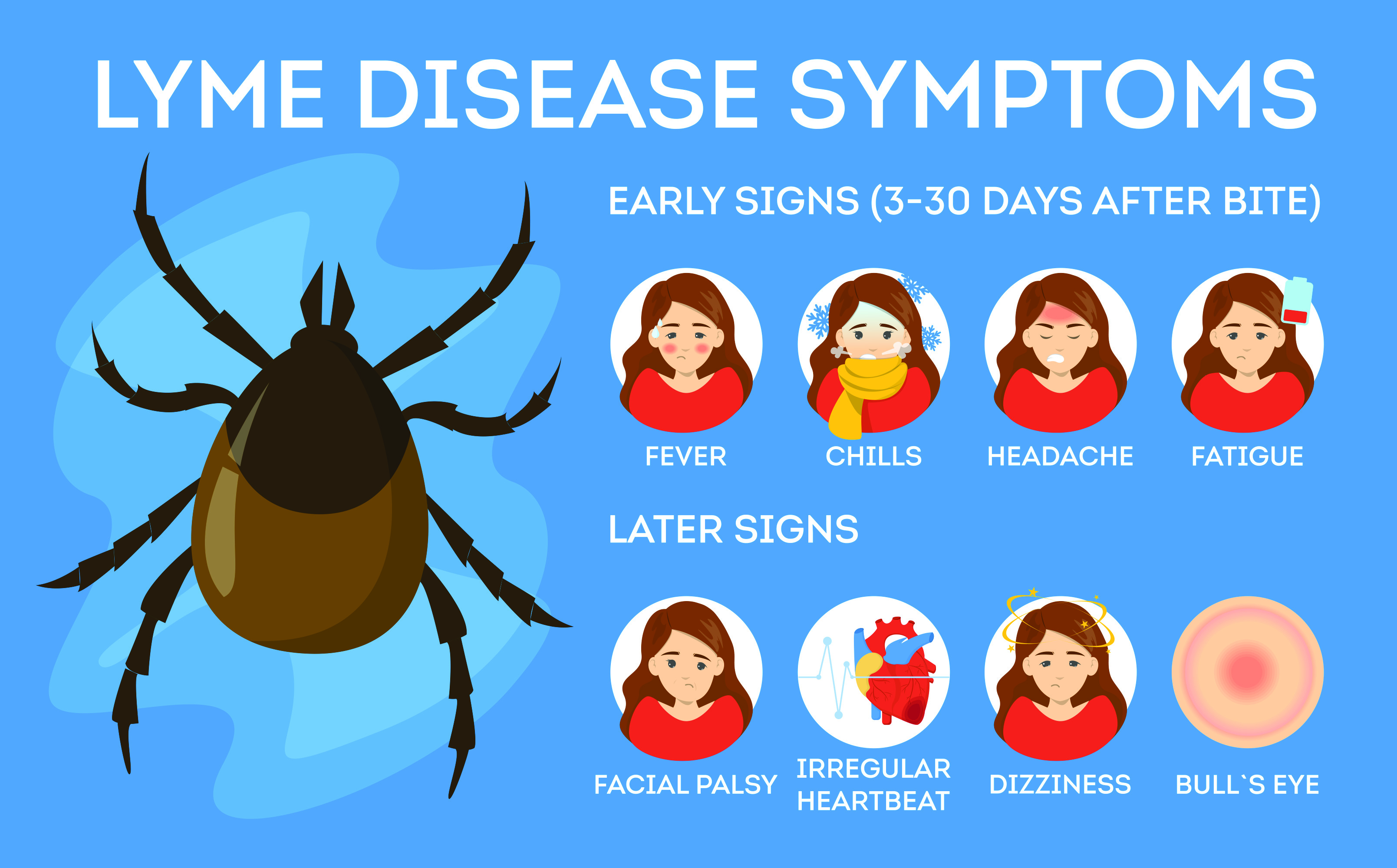Lyme Disease
Spring Bites : Preventing Lyme Disease: As spring unfolds, people across the country emerge from their wintertime captivity to enjoy the great outdoors. Unfortunately, another creature makes an entrance in the spring too — the deer tick, best known as the carrier of Lyme disease. Lyme disease is a serious bacterial infection that can affect your joints, nervous system and heart. The key to preventing the disease is avoiding tick bites. Stay bite-free and keep your children and pets bite-free too. Please vaccinate your pets, ask your veterinarian.
![]() Lyme disease was first described in the United States in the town of Old Lyme, Connecticut in 1977, but has now been reported in most parts of the United States. Most cases occur in the Northeast, upper Midwest, and along the Pacific coast. Mice and deer are the most commonly infected animals that serve as host to the tick. Most infections occur in the spring and summer. The bacteria that causes this disease is named: Borrelia burgdorferi, it is a spirochete (as is Syphilis). Lyme Disease is NOT contagious from one person to another, although the spirochete has been shown to cross the placenta. If you are pregnant and think you have Lyme Disease consult with your health care provider.
Lyme disease was first described in the United States in the town of Old Lyme, Connecticut in 1977, but has now been reported in most parts of the United States. Most cases occur in the Northeast, upper Midwest, and along the Pacific coast. Mice and deer are the most commonly infected animals that serve as host to the tick. Most infections occur in the spring and summer. The bacteria that causes this disease is named: Borrelia burgdorferi, it is a spirochete (as is Syphilis). Lyme Disease is NOT contagious from one person to another, although the spirochete has been shown to cross the placenta. If you are pregnant and think you have Lyme Disease consult with your health care provider.
The disease is difficult to diagnose, because the symptoms mimic other diseases. A characteristic red rash usually occurs at the site of the bite; however, the bite may go unnoticed. A few months after the bite, muscle paralysis, joint inflammation, neurological symptoms and sometimes heart symptoms may occur.
The initial infection is called primary Lyme disease, secondary Lyme disease and tertiary Lyme disease may develop.


From left to right: The deer tick adult female, adult male, nymph, and larva on a centimeter scale.
These carry the bacteria Borrelia burgdorferi, so it’s not really the tick at all, but the bacteria that it carries. That is why we call it a vector. NOT all ticks carry the bacteria. The large ones you might find on your dog usually do not.
Prevention
If you reside, work, or play in areas where you are frequently exposed to ticks, you may want to consider being immunized with LYMErix vaccine to prevent Lyme disease. Contact your health care provider if you live in a Lyme disease high-risk area. The following precautions also help lower your risk of becoming infected. When walking in on near wooded areas use insect repellent with DEET.
When walking or hiking in tick infested areas, tuck long pants into socks to protect the legs, wear shoes and long-sleeved shirts. Ticks will show up on white or light colors better than dark colors, making them easier to remove from your clothing. Check yourself and your pets frequently. If you find ticks, remove them immediately by using a tweezers, pulling carefully and steadily. Insect repellent may be helpful.
![]()
Symptoms:²
Early symptoms (seven to ten days):
An illness with flu-like symptoms during spring and summer.
A skin rash which varies in size, shape and color, but often looks like a “bull’s eye”.
Joint or muscle pain
A flat or slightly raised red lesion (erythema migrans) at the site of the tick bite. This lesion is larger than 3 to 5 centimeters in diameter often with a clear area in the center. (Children often get the rash, but many adults do not for some unknown reason. (I had Lyme twice and never had a rash).
Expansion of the red lesion to several inches over several days. The resulting rash will usually clear in the center, creating an annular rash.
Fever
Headache
Fatigue
Muscle pains
Stiff neck
Joint inflammation in the knees and other large joints
Headache at the base of the neck
Strange, unusual or hostile behavior (not so common, but can occur in later disease).
Later symptoms (months to years):
Arthritis, especially in knees and hips.
Problems with the nervous system.
Heart problems
![]()
Tests For Lyme Disease
Physical examination
Antibodies to B. Burgdorferi by immunofluorescence (IFA) or ELISA.
Borderline ELISA tests are confirmed with a Western blot test.
Treatment²² ²
Antibiotics are prescribed based on disease stages and manifestations. Doxycycline, cefuroxime, ceftriaxone, and penicillin are some of the choices. Anti-inflammatory medications are prescribed to relieve joint stiffness. (Note: doxycycline is usually not prescribed for children until after all the permanent teeth have erupted; it can permanently discolor teeth that are still forming).
If diagnosed in the early stages, the disease can be cured with antibiotics. If left untreated, complications involving joints, the heart, and the nervous system can occur.
Call your health care provider if symptoms of Lyme disease develop.
Can It Be Prevented?
Avoid tick bites to prevent Lyme disease:
Be knowledgeable about the risk of tick bites in your area.
Wear protective clothing outdoors, a hat is good too, they can get on the scalp too.
Check yourself, children and pets for ticks.
Clear away brushy or grassy areas around the home.
Use a tick repellent on clothing. Make sure it has DEET in it.
Prevention Outside Your Home
For those of you who enjoy spending time in your yards in high risk areas, reduce the tick population around the home by:
Keeping lawns mowed and edges trimmed.
Clearing brush, leaf litter and tall grass around houses and at the edges of gardens and open stone walls.
Stacking woodpiles neatly in a dry location — off of the ground.
Keep the ground under bird feeders clean so as not to attract small mammals, or avoid bird feeders all together. Yes, squirrels carry the deer ticks now in many Mid-Atlantic States.
Have a licensed professional spray the residential environment (only the areas frequented by humans) with an insecticide in late May (to control nymphs) and optionally in September (to control adults). I know this is not good for the water supply in many areas, find out where your well is if you have one. It is worse to get Lyme Disease than to do this for yourself and your family.
![]()
To Remove a Tick
Using a pair of fine tipped tweezers, grasp the tick as close to the skin as possible and pull it straight out until it releases its hold on the skin. To reduce the chance of contact with the bacterium, try not to crush the tick’s body. After removing the tick, wash the bite area with soap and water.
Do not use mineral oil, vaseline or a hot match to remove a tick! These methods do not make the tick “back out”. This may cause the tick to inject bacteria into the skin. Remember that if you remove a tick before it is attached for more than 48 hours, you can greatly reduce the chance of contracting Lyme disease.
Watch the site of the bite for the appearance of a rash beginning 3 to 30 days after the bite. At the same time, learn about the other early symptoms of Lyme disease and watch to see if they appear in about the same timeframe. If a rash or other early symptoms develop, call your health care provider.
Need More Info: See the Lyme Disease Focus – use drop-down or Video…
![]()
Resources on the Web:
24-Hour Hotline in the US: 800-886-LYME
Lyme Disease Foundation – http://www.lyme.org
Centers for Disease Control and Prevention
970-221-6400
Lyme Disease Foundation, Inc.
One Financial Plaza, 18th Floor
Hartford, CT 06103
860-525-2000
![]()

(Map and Photos From the Centers for Disease Control)
To the Lyme FAQ Page… Go There…
